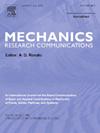在动态应变老化域内对高温条件下添加制造的 SS316 合金进行梯度评估
IF 1.9
4区 工程技术
Q3 MECHANICS
引用次数: 0
摘要
本研究评估了在高温范围内发生动态应变老化(DSA)现象的不对称加载循环下,加成制造(AM)不锈钢 316 样品中塑性应变的累积情况。通过使用各向同性运动硬化组合框架,对 AM 钢样品的棘轮响应进行了评估。通过指数函数ψ(p,T)将动态应变时效引入艾哈迈德扎德-瓦尔瓦尼(A-V)运动硬化规则的动态恢复项中。该函数使硬化框架能够评估 AM 钢样品在 DSA 域内工作温度下的棘轮效应。AM SS316 样品的 DSA 温度范围在 700 K 到 1140 K 之间。在此温度范围内,溶质原子和位错之间的相互作用提高了材料强度,并抑制了加载循环中的棘突幅度。使用 A-V 模型进一步讨论了 DSA 对背应力演变和偏差应力空间屈服面的影响,以及随后对样品棘变的影响。结果发现,DSA 温度域下的预测棘轮曲线与测量值非常接近。本文章由计算机程序翻译,如有差异,请以英文原文为准。
Ratcheting assessment of additively manufactured SS316 alloys at elevated temperatures within the dynamic strain aging domain
The present study has evaluated the accumulation of plastic strain in additively manufactured (AM) stainless steel 316 samples undergoing asymmetric loading cycles at elevated temperature range where the dynamic strain aging (DSA) phenomenon occurred. The ratcheting response of AM steel samples were assessed through the use of the combined isotropic-kinematic hardening framework. The dynamic strain aging was introduced into the dynamic recovery term of the Ahmadzadeh-Varvani (A-V) kinematic hardening rule by an exponential function ψ(p, T). This function enabled the hardening framework to evaluate the ratcheting of AM steel samples at operating temperatures within the DSA domain. The DSA temperature range for AM SS316 samples fell between 700 K to 1140 K. Within this temperature domain, the interaction between solute atoms and dislocations led to an increase in material strength and suppressed the magnitude of ratcheting over the loading cycles. The influence of DSA on the backstress evolution and the yield surfaces translated in the deviatoric stress space and their subsequent influence on the ratcheting of samples using the A-V model were further discussed. The predicted ratcheting curves at the DSA temperature domain were found in close agreement with those of measured values.
求助全文
通过发布文献求助,成功后即可免费获取论文全文。
去求助
来源期刊
CiteScore
4.10
自引率
4.20%
发文量
114
审稿时长
9 months
期刊介绍:
Mechanics Research Communications publishes, as rapidly as possible, peer-reviewed manuscripts of high standards but restricted length. It aims to provide:
• a fast means of communication
• an exchange of ideas among workers in mechanics
• an effective method of bringing new results quickly to the public
• an informal vehicle for the discussion
• of ideas that may still be in the formative stages
The field of Mechanics will be understood to encompass the behavior of continua, fluids, solids, particles and their mixtures. Submissions must contain a strong, novel contribution to the field of mechanics, and ideally should be focused on current issues in the field involving theoretical, experimental and/or applied research, preferably within the broad expertise encompassed by the Board of Associate Editors. Deviations from these areas should be discussed in advance with the Editor-in-Chief.

 求助内容:
求助内容: 应助结果提醒方式:
应助结果提醒方式:


